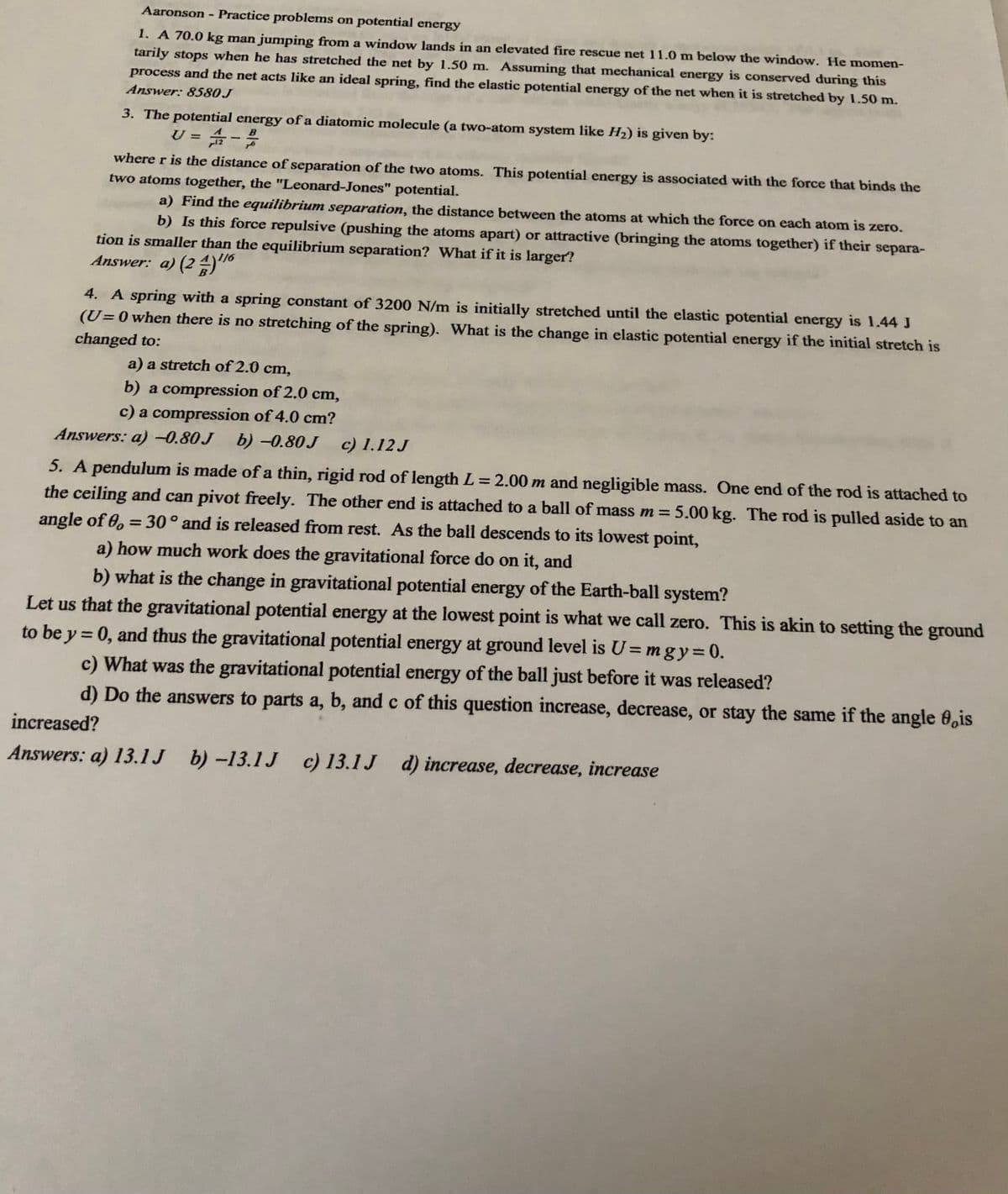energy 1. A 70.0 kg man jumping from a window lands in an elevated fire rescue net 11.0 m below the window. He momen- tarily stops when he has stretched the net by 1.50 m. Assuming that mechanical energy is conserved during this process and the net acts like an ideal spring, find the elastic potential energy of the net when it is stretched by 1.50 m. Answer: 8580J
energy 1. A 70.0 kg man jumping from a window lands in an elevated fire rescue net 11.0 m below the window. He momen- tarily stops when he has stretched the net by 1.50 m. Assuming that mechanical energy is conserved during this process and the net acts like an ideal spring, find the elastic potential energy of the net when it is stretched by 1.50 m. Answer: 8580J
Physics for Scientists and Engineers: Foundations and Connections
1st Edition
ISBN:9781133939146
Author:Katz, Debora M.
Publisher:Katz, Debora M.
Chapter8: Conservation Of Energy
Section: Chapter Questions
Problem 24PQ: A block is placed on top of a vertical spring, and the spring compresses. Figure P8.24 depicts a...
Related questions
Question
Please solve all of 5

Transcribed Image Text:Aaronson Practice problems on potential energy
1. A 70.0 kg man jumping from a window lands in an elevated fire rescue net 11.0 m below the window. He momen-
tarily stops when he has stretched the net by 1.50 m. Assuming that mechanical energy is conserved during this
process and the net acts like an ideal spring, find the elastic potential energy of the net when it is stretched by 1.50 m.
Answer: 8580J
3. The potential energy of a diatomic molecule (a two-atom system like H2) is given by:
U = -
B
%3D
where r is the distance of separation of the two atoms. This potential energy is associated with the force that binds the
two atoms together, the "Leonard-Jones" potential.
a) Find the equilibrium separation, the distance between the atoms at which the force on each atom is zero.
b) Is this force repulsive (pushing the atoms apart) or attractive (bringing the atoms together) if their separa-
tion is smaller than the equilibrium separation? What if it is larger?
Answer: a) (2 "
4. A spring with a spring constant of 3200 N/m is initially stretched until the elastic potential energy is 1.44 J
(U=0 when there is no stretching of the spring). What is the change in elastic potential energy if the initial stretch is
changed to:
a) a stretch of 2.0 cm,
b) a compression of 2.0 cm,
c) a compression of 4.0 cm?
b) -0.80 J
Answers: a)-0.80J
c) 1.12 J
5. A pendulum is made of a thin, rigid rod of length L= 2.00 m and negligible mass. One end of the rod is attached to
%3D
the ceiling and can pivot freely. The other end is attached to a ball of mass m = 5.00 kg. The rod is pulled aside to an
angle of 0, = 30° and is released from rest. As the ball descends to its lowest point,
%3D
a) how much work does the gravitational force do on it, and
b) what is the change in gravitational potential energy of the Earth-ball system?
Let us that the gravitational potential energy at the lowest point is what we call zero. This is akin to setting the ground
to be y = 0, and thus the gravitational potential energy at ground level is U= mgy=0.
c) What was the gravitational potential energy of the ball just before it was released?
d) Do the answers to parts a, b, and c of this question increase, decrease, or stay the same if the angle 0,is
%3D
%3D
increased?
Answers: a) 13.1J b) -13.1 J c) 13.1J d) increase, decrease, increase
Expert Solution
This question has been solved!
Explore an expertly crafted, step-by-step solution for a thorough understanding of key concepts.
Step by step
Solved in 3 steps

Knowledge Booster
Learn more about
Need a deep-dive on the concept behind this application? Look no further. Learn more about this topic, physics and related others by exploring similar questions and additional content below.Recommended textbooks for you

Physics for Scientists and Engineers: Foundations…
Physics
ISBN:
9781133939146
Author:
Katz, Debora M.
Publisher:
Cengage Learning

College Physics
Physics
ISBN:
9781305952300
Author:
Raymond A. Serway, Chris Vuille
Publisher:
Cengage Learning

College Physics
Physics
ISBN:
9781285737027
Author:
Raymond A. Serway, Chris Vuille
Publisher:
Cengage Learning

Physics for Scientists and Engineers: Foundations…
Physics
ISBN:
9781133939146
Author:
Katz, Debora M.
Publisher:
Cengage Learning

College Physics
Physics
ISBN:
9781305952300
Author:
Raymond A. Serway, Chris Vuille
Publisher:
Cengage Learning

College Physics
Physics
ISBN:
9781285737027
Author:
Raymond A. Serway, Chris Vuille
Publisher:
Cengage Learning

Physics for Scientists and Engineers with Modern …
Physics
ISBN:
9781337553292
Author:
Raymond A. Serway, John W. Jewett
Publisher:
Cengage Learning

Physics for Scientists and Engineers
Physics
ISBN:
9781337553278
Author:
Raymond A. Serway, John W. Jewett
Publisher:
Cengage Learning

Principles of Physics: A Calculus-Based Text
Physics
ISBN:
9781133104261
Author:
Raymond A. Serway, John W. Jewett
Publisher:
Cengage Learning